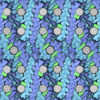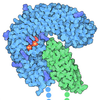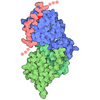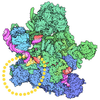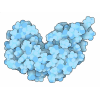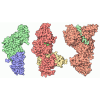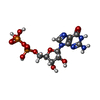+ Open data
Open data
- Basic information
Basic information
| Entry | Database: PDB / ID: 9ci3 | ||||||
|---|---|---|---|---|---|---|---|
| Title | Structure of the LRRK2/14-3-3 complex | ||||||
 Components Components |
| ||||||
 Keywords Keywords | TRANSFERASE/SIGNALING PROTEIN / LRRK2 / LRRK2 complex / LRRK2 14-3-3 complex / LRRK2 autoinhibited / TRANSFERASE / TRANSFERASE-SIGNALING PROTEIN complex | ||||||
| Function / homology |  Function and homology information Function and homology informationcaveola neck / negative regulation of protein processing involved in protein targeting to mitochondrion / Wnt signalosome assembly / beta-catenin destruction complex binding / regulation of branching morphogenesis of a nerve / regulation of kidney size / regulation of cell projection organization / tangential migration from the subventricular zone to the olfactory bulb / protein localization to endoplasmic reticulum exit site / GTP-dependent protein kinase activity ...caveola neck / negative regulation of protein processing involved in protein targeting to mitochondrion / Wnt signalosome assembly / beta-catenin destruction complex binding / regulation of branching morphogenesis of a nerve / regulation of kidney size / regulation of cell projection organization / tangential migration from the subventricular zone to the olfactory bulb / protein localization to endoplasmic reticulum exit site / GTP-dependent protein kinase activity / regulation of SNARE complex assembly / regulation of neuroblast proliferation / regulation of ER to Golgi vesicle-mediated transport / peroxidase inhibitor activity / negative regulation of late endosome to lysosome transport / regulation of mitochondrial depolarization / negative regulation of protein targeting to mitochondrion / positive regulation of dopamine receptor signaling pathway / amphisome / regulation of synaptic vesicle transport / positive regulation of cell-cell adhesion / regulation of CAMKK-AMPK signaling cascade / regulation of lysosomal lumen pH / co-receptor binding / negative regulation of GTPase activity / phosphorylation-dependent protein binding / regulation of dopamine receptor signaling pathway / mitochondrion localization / regulation of neuron maturation / positive regulation of microglial cell activation / regulation of retrograde transport, endosome to Golgi / positive regulation of synaptic vesicle endocytosis / cytoplasmic side of mitochondrial outer membrane / negative regulation of excitatory postsynaptic potential / negative regulation of autophagosome assembly / JUN kinase kinase kinase activity / olfactory bulb development / neuron projection arborization / multivesicular body, internal vesicle / striatum development / positive regulation of T cell mediated immune response to tumor cell / regulation of dendritic spine morphogenesis / protein localization to mitochondrion / cellular response to dopamine / positive regulation of mitochondrial outer membrane permeabilization involved in apoptotic signaling pathway / endoplasmic reticulum organization / positive regulation of protein autoubiquitination / Wnt signalosome / positive regulation of programmed cell death / negative regulation of protein processing / GTP metabolic process / regulation of canonical Wnt signaling pathway / regulation of neuron differentiation / syntaxin-1 binding / regulation of reactive oxygen species metabolic process / lysosome organization / Golgi-associated vesicle / clathrin binding / protein kinase A binding / regulation of locomotion / PTK6 promotes HIF1A stabilization / negative regulation of macroautophagy / neuromuscular junction development / protein kinase C inhibitor activity / regulation of cAMP/PKA signal transduction / regulation of mitochondrial fission / Golgi organization / regulation of synaptic vesicle exocytosis / exploration behavior / microvillus / intracellular distribution of mitochondria / endoplasmic reticulum exit site / autolysosome / locomotory exploration behavior / Regulation of localization of FOXO transcription factors / negative regulation of Notch signaling pathway / Activation of BAD and translocation to mitochondria / regulation of signal transduction / MAP kinase kinase kinase activity / regulation of synaptic vesicle endocytosis / canonical Wnt signaling pathway / protein targeting / Chk1/Chk2(Cds1) mediated inactivation of Cyclin B:Cdk1 complex / regulation of synaptic transmission, glutamatergic / SARS-CoV-2 targets host intracellular signalling and regulatory pathways / negative regulation of endoplasmic reticulum stress-induced intrinsic apoptotic signaling pathway / negative regulation of protein kinase activity / cellular response to glucose starvation / presynaptic cytosol / Rho protein signal transduction / SARS-CoV-1 targets host intracellular signalling and regulatory pathways / RHO GTPases activate PKNs / phagocytic vesicle / neuron projection morphogenesis / JNK cascade / cellular response to manganese ion / negative regulation of TORC1 signaling / insulin-like growth factor receptor binding / positive regulation of autophagy / Transcriptional and post-translational regulation of MITF-M expression and activity Similarity search - Function | ||||||
| Biological species |  Homo sapiens (human) Homo sapiens (human) | ||||||
| Method | ELECTRON MICROSCOPY / single particle reconstruction / cryo EM / Resolution: 3.96 Å | ||||||
 Authors Authors | Martinez Fiesco, J.A. / Zhang, P. | ||||||
| Funding support |  United States, 1items United States, 1items
| ||||||
 Citation Citation |  Journal: Nat Commun / Year: 2025 Journal: Nat Commun / Year: 2025Title: 14-3-3 binding maintains the Parkinson's associated kinase LRRK2 in an inactive state. Authors: Juliana A Martinez Fiesco / Alexandra Beilina / Astrid Alvarez de la Cruz / Ning Li / Riley D Metcalfe / Mark R Cookson / Ping Zhang /  Abstract: Leucine-rich repeat kinase 2 (LRRK2) is an essential regulator in cellular signaling and a major contributor to Parkinson's disease (PD) pathogenesis. 14-3-3 proteins are critical modulators of LRRK2 ...Leucine-rich repeat kinase 2 (LRRK2) is an essential regulator in cellular signaling and a major contributor to Parkinson's disease (PD) pathogenesis. 14-3-3 proteins are critical modulators of LRRK2 activity, yet the structural basis of their interaction has remained unclear. Here, we present the cryo-electron microscopy structure of the LRRK2:14-3-3 autoinhibitory complex, revealing how a 14-3-3 dimer stabilizes an autoinhibited LRRK2 monomer through dual-site anchoring. The dimer engages both phosphorylated S910/S935 sites and the COR-A/B subdomains within the Roc-COR GTPase region. This spatial configuration constrains LRR domain mobility, reinforces the inactive conformation, and likely impedes LRRK2 dimerization and oligomer formation. Structure-guided mutagenesis studies show that PD-associated mutations at the COR:14-3-3 interface and within the GTPase domain weaken 14-3-3 binding and impair its inhibitory effect on LRRK2 kinase activity. Furthermore, we demonstrate that type I LRRK2 kinase inhibitor, which stabilizes the kinase domain in its active conformation, reduces 14-3-3 binding and promotes dephosphorylation at pS910 and pS935. Together, these findings provide a structural basis for understanding how LRRK2 is maintained in an inactive state, elucidate the mechanistic role of 14-3-3 in LRRK2 regulation, inform the interpretation of PD biomarkers, and suggest therapeutic strategies aimed at enhancing LRRK2-14-3-3 interactions to treat PD and related disorders. | ||||||
| History |
|
- Structure visualization
Structure visualization
| Structure viewer | Molecule:  Molmil Molmil Jmol/JSmol Jmol/JSmol |
|---|
- Downloads & links
Downloads & links
- Download
Download
| PDBx/mmCIF format |  9ci3.cif.gz 9ci3.cif.gz | 389.7 KB | Display |  PDBx/mmCIF format PDBx/mmCIF format |
|---|---|---|---|---|
| PDB format |  pdb9ci3.ent.gz pdb9ci3.ent.gz | 294.6 KB | Display |  PDB format PDB format |
| PDBx/mmJSON format |  9ci3.json.gz 9ci3.json.gz | Tree view |  PDBx/mmJSON format PDBx/mmJSON format | |
| Others |  Other downloads Other downloads |
-Validation report
| Summary document |  9ci3_validation.pdf.gz 9ci3_validation.pdf.gz | 1.2 MB | Display |  wwPDB validaton report wwPDB validaton report |
|---|---|---|---|---|
| Full document |  9ci3_full_validation.pdf.gz 9ci3_full_validation.pdf.gz | 1.2 MB | Display | |
| Data in XML |  9ci3_validation.xml.gz 9ci3_validation.xml.gz | 71.1 KB | Display | |
| Data in CIF |  9ci3_validation.cif.gz 9ci3_validation.cif.gz | 104.6 KB | Display | |
| Arichive directory |  https://data.pdbj.org/pub/pdb/validation_reports/ci/9ci3 https://data.pdbj.org/pub/pdb/validation_reports/ci/9ci3 ftp://data.pdbj.org/pub/pdb/validation_reports/ci/9ci3 ftp://data.pdbj.org/pub/pdb/validation_reports/ci/9ci3 | HTTPS FTP |
-Related structure data
| Related structure data |  45609MC M: map data used to model this data C: citing same article ( |
|---|---|
| Similar structure data | Similarity search - Function & homology  F&H Search F&H Search |
- Links
Links
- Assembly
Assembly
| Deposited unit | 
|
|---|---|
| 1 |
|
- Components
Components
| #1: Protein | Mass: 30436.814 Da / Num. of mol.: 2 Source method: isolated from a genetically manipulated source Source: (gene. exp.)  Homo sapiens (human) / Gene: YWHAG / Production host: Homo sapiens (human) / Gene: YWHAG / Production host:  #2: Protein | | Mass: 290652.188 Da / Num. of mol.: 1 / Mutation: R50H variant Source method: isolated from a genetically manipulated source Source: (gene. exp.)  Homo sapiens (human) / Gene: LRRK2, PARK8 / Production host: Homo sapiens (human) / Gene: LRRK2, PARK8 / Production host:  Homo sapiens (human) Homo sapiens (human)References: UniProt: Q5S007, non-specific serine/threonine protein kinase, Hydrolases; Acting on acid anhydrides; Acting on GTP to facilitate cellular and subcellular movement #3: Chemical | ChemComp-GDP / | Has ligand of interest | N | Has protein modification | Y | |
|---|
-Experimental details
-Experiment
| Experiment | Method: ELECTRON MICROSCOPY |
|---|---|
| EM experiment | Aggregation state: PARTICLE / 3D reconstruction method: single particle reconstruction |
- Sample preparation
Sample preparation
| Component |
| ||||||||||||||||||||||||
|---|---|---|---|---|---|---|---|---|---|---|---|---|---|---|---|---|---|---|---|---|---|---|---|---|---|
| Molecular weight | Value: 342.7 kDa/nm / Experimental value: NO | ||||||||||||||||||||||||
| Source (natural) |
| ||||||||||||||||||||||||
| Source (recombinant) |
| ||||||||||||||||||||||||
| Buffer solution | pH: 8.3 | ||||||||||||||||||||||||
| Specimen | Conc.: 0.2 mg/ml / Embedding applied: NO / Shadowing applied: NO / Staining applied: NO / Vitrification applied: YES | ||||||||||||||||||||||||
| Specimen support | Grid material: GOLD / Grid mesh size: 300 divisions/in. / Grid type: Quantifoil R1.2/1.3 | ||||||||||||||||||||||||
| Vitrification | Instrument: LEICA EM GP / Cryogen name: ETHANE / Humidity: 90 % / Chamber temperature: 60.8 K |
- Electron microscopy imaging
Electron microscopy imaging
| Microscopy | Model: TFS TALOS |
|---|---|
| Electron gun | Electron source:  FIELD EMISSION GUN / Accelerating voltage: 200 kV / Illumination mode: FLOOD BEAM FIELD EMISSION GUN / Accelerating voltage: 200 kV / Illumination mode: FLOOD BEAM |
| Electron lens | Mode: BRIGHT FIELD / Nominal defocus max: 1200 nm / Nominal defocus min: 800 nm |
| Image recording | Electron dose: 50 e/Å2 / Film or detector model: GATAN K3 BIOCONTINUUM (6k x 4k) |
- Processing
Processing
| EM software |
| ||||||||||||||||||||||||
|---|---|---|---|---|---|---|---|---|---|---|---|---|---|---|---|---|---|---|---|---|---|---|---|---|---|
| CTF correction | Type: PHASE FLIPPING AND AMPLITUDE CORRECTION | ||||||||||||||||||||||||
| 3D reconstruction | Resolution: 3.96 Å / Resolution method: FSC 0.143 CUT-OFF / Num. of particles: 432285 / Symmetry type: POINT | ||||||||||||||||||||||||
| Refinement | Highest resolution: 3.96 Å Stereochemistry target values: REAL-SPACE (WEIGHTED MAP SUM AT ATOM CENTERS) | ||||||||||||||||||||||||
| Refine LS restraints |
|
 Movie
Movie Controller
Controller



 PDBj
PDBj